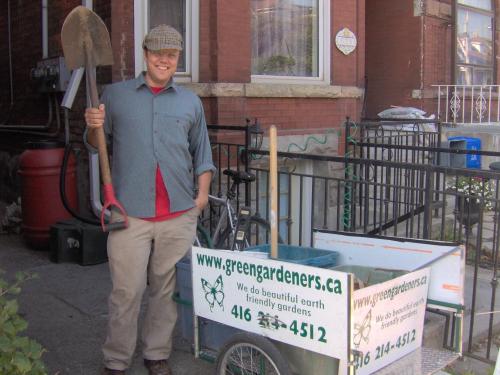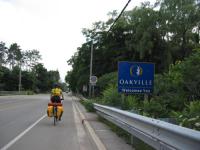Herb's comment: Andrew and I had a great talk about a lot of his ideas of how to expand bike-based businesses, using homes for a new green economy, and why he chose this particular bike trailer over more local versions or cargo bikes, but these I can provide in the comments if you are interested. As usual the interviewees are quite interesting folk! Read on...
Name / Occupation / Age:
Andrew Roy / Ecological Gardening Entrepreneur / 36
What do you use your bike for?
It's my main mode of personal transportation. For the business [Ed: Green Gardeners of Toronto], it used to be THE only vehicle - bike trailers are now used for certain jobs in certain areas.
Why did you chose to use bicycles for your business?
Our business was incubated from a project at the North Toronto Green Community (now Toronto Green Community). The idea was to have a zero emission gardening service both in terms of push mowing and hand tools as well as no trucks. We received support from EcoAction and we were off to the races.
Personally, it is quite empowering to know that I could ride, earn a living and not be dependent on a less than sustainable geopolitical system / economy.
A bicycle based business changes the way you look at a firm's role in local economic development in an urban environment. If you had to pedal with human power, all the stuff that makes life function - we would probably have a smaller footprint.
We are looking to revision our business model to perhaps look at getting more trailers and working from various bases across the city.
Can you give a brief description of how you use bicycles on a typical day?
Almost all of our employees ride to work. A Two Bike Trailers Crew are used on certain maintenance days when we are close to home base. Bike Trailers can also be used when at a job for more than 3 or 4 hours at a time.
Needless to say there are time disadvantages to travel time as well as unloading / packing time. However, it almost balances out with the fact that you get noticed and it is great public relations.
How often do you ride?
Since my herculean days of riding massive kilometres, I have taken a more office based role. I now ride to see clients as often as I can and I personally will ride a bike trailer about once or twice a week to a job or community event.
What's the best thing about working or commuting by bicycle?
Some of the points mentioned above. Fitness being another positive as well as you need to develop a certain hyper awareness keeping track of trajectories of vehicles, car doors, timing lights etc. I would say that I feel truly alive while cycling.
Cycling can and shall be more prevalent on a mass scale as peak oil manifests!
Any new advice for new riders?
Don't let fear get in the way of taking the first step. Ride smart - try to connect with drivers with eye contact and hand signals. Stay away from certain unpleasant arterial road ways. Realize that there is a massive community of cyclists that are on your side. Drivers are human too!
What would you say to convince someone who is considering using bicycles for their business?
People love it and you will get noticed!
What do you like about biking in Toronto?
Some days when there are more than 10 gathered at a light waiting to go! Seeing the city from a non-automobile perspective. Being able to ride with no hands while in some neighbourhoods and looking at gardens while I ride. Biking is faster than driving and parking in many instances.
Riding fast with the trailer and turning heads.
What do you dislike about biking in Toronto?
That the infrastructure is not in place to displace cars and the underlying politics of the automobile vis a vis economics.
That road chaos and jungle type mentality in traffic flows from really bad urban design and a lack of political will / wherewithal.
Where is/are your favourite place(s) to bike in Toronto?
Anywhere I go.
What's your favourite cycling street in Toronto? Least favourite?
Most:
Yonge Street
Harbord St
Across the Bloor Viaduct
Up the Iroquois Shoreline Hill
Least:
Bayview by far!
Favourite bike stories?
The one day I rode from Parkdale to Downsview across to North East Scarborough with the Trailer. Not economical by any stretch but at least I can say I did it
What is your favourite piece of cycling kit/clothing/gadget?
Fairly minimalist about gear.
What sort of bike do you ride?
After having a few loved bikes stolen (and yes, you will probably have one stolen too) now a Marin Hybrid.
What sort of trailer do you use?
Human Powered Machines - Hauler [Ed: manufactured at the Center for Appropriate Transportation in Eugene, Oregon]. Best thing I ever bought. Excellent Design: Low centre of gravity, perfect size for wheelbarrows and 110L Rubbermaids. Would love 10 more if I can find someone to manufacture them in Toronto locally (wink, wink).
How could the city help you enjoy riding more?
- More bike lanes.
- More car free street days.
Scary bike story?
Riding on Yonge St North on a Saturday Morning down the York Mills Valley Hill and I could not stop at the red with two cars waiting - had to ride in between them to avoid a collision. That I avoid door prizes on a daily basis.
Helmet or no helmet?
No helmet.
Bike lane or no bike lane?
Bike lanes when possible!


